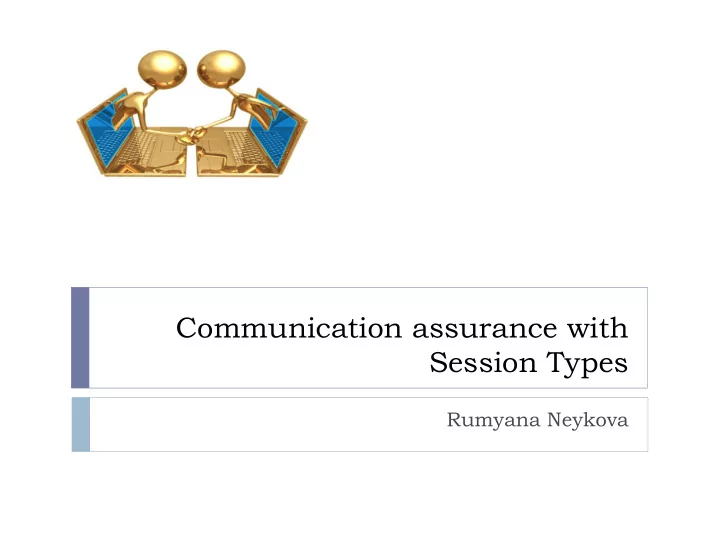

Communication assurance with Session Types Rumyana Neykova
Communication Safety with Session Types Promises: Organising structured communications from a global point of view Efficient type-checking strategy of processes through projection of global types onto participants
The shortcoming When the endpoints are not typed… the communication assurance is lost
Runtime Verification to the rescue Transport Monitor Monitor Monitor P Bob P Alice P Carol Attach monitor to each untyped participant. Monitors check that every incoming and outgoing message is correct wrt the protocol specifications.
Content Session Types Overview Runtime Verification Overview Monitoring Demo Future Directions
Session Types in a Nutshell “… Session Types structure a series of interactions in a simple and concise syntax and ensure type safe communication .”
Session Types Guarantees Communication Safety • No communication mismatch Session Fidelity • Communication follow the described protocol Progress • No deadlock/ stuck in a session
Example Alice Carol Seller Bob How it works? Step 1: Write Global Type quote quote Step 2: Write Local Programs Step 3: Project and Type Check Locally Delegate T ok ok Address Date
Step 1: Write Global Types
Step 2: Projections
Typing System Typing judgement are of the shape:
Evolution Binary Session Types [THK98, HVK98] Myltiparty Session Types [POPL’08] Progress in Interleaved Multiparty Sessions [Concur’08] Session Types with Assertions [Concur’11] Dynamic Multirole session types [POPL’11]
Limitations … Proving communication assurance in the presence of untyped endpoints is a problem for the existing theory since it relies on typing. An alternative mechanisms for validations is needed !!!
Runtime Verification “…Formal method that is used for monitoring of a program being executed by verifying the generated events against a set of properties”
The process Properties are written in some formal logic - specification language The properties are transformed into runtime monitor which is instrumented with the system to be monitored A runtime monitor observes the system while it is running The monitor triggers an appropriate response if a system property is violated.
Components 1. System to be monitored 2. Set of specifications written in some formal notation 3. Stream of events extracted from the system ( trace ) 4. Monitor ing system which receives the events and verifies
Specification Language “Specification language should be properly chosen to meet the properties that need to be enforced.” What kind of properties to specify? Temporal properties Consequential: authentication happens before data access real-time: transaction takes no more than 30 sec to execute Contextual properties: possibility to monitoring objects either globally or locally Exceptions related: monitoring all exceptional cases in the execution of the program
Various Options for specification Language “Defining a specification language is a problem of choosing the optimal balance between simplicity, efficiency and effectiveness” The language can be based on: Algebra Logic Regular expressions Automata It can be fully featured language Functional Imperative Object-oriented Extension of an existing language
Monitor “A monitor is a system that observes the behaviour of a system and determines if it is consistent with a given specification”
Example of RV tools Enforce Real-time properties JRMTC Larva Fully functional Design By Contract ASML JASS specification Approach language Self-checking Obser distributed system ver
OOI(Ocean Observation Initiative) Aim: to deploy an infrastructure to expand the scientists’ ability to remotely study the ocean Builds on large scale infrastructure Distributed components are managed under diverse administrative domains Active entities participants and organizations are called agents, agents must conform to norms Need for global safety ensurance by local validation with possibly unsafe endpoints
OOI Use Case : Instrument Command
Use Case
Distributed Monitor (External) monitors : drop violating incoming and ongoing messages Check: session initialisation messages within sessions
Properties Local/global conformance: a monitored process well- behaves and coherence is preserved in a network Local/global transparency: monitors do not alter well-behaved interactions Session fidelity: the interactions of a network are step-by-step conform to the corresponding global types
Demo Time Demo
Demo Notes Untrusted code runs on end-point machines. They communicate through a common transport (AMQP). Monitors check that every incoming and outgoing message is correct wrt the protocol specifications
Future Directions Runtime enforcements Exception Handling Real-Time Properties Contextual Properties
Q & A
Appendix OOI AMQP Monitor Properties
Recommend
More recommend